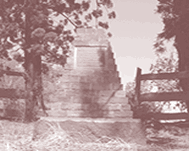

 |
 |
||
|
| Heritage Buildings Blacktown Central Public School, Blacktown built in 1876 and located in Flushcombe Road once included several other buildings. It was an infants and primary school, and for a while also included a school at Hereward Highway. The oldest building, with two infants classrooms continued to operate until the school was closed. Children felt very privileged to have their classes in the old building. Banksia shrubs lined the footpath. The adjacent Catholic School and the old Blacktown Registry once occupied nearly the entire block. Westpoint shopping complex now occupies the rest of the site.
Prospect Post Office, Prospect. This building has had many functions, it is often referred to as the old Prospect Post Office. It was located on the old Great Western Highway and was once a hive of local activity. It has a new roof and bullnose verandah awning, unfortunately the windows are boarded up and a fence surrounds the building to deter vandals. Admirably, it has been preserved by the NSW Department of Infrastructure, Natural Resources and Planning.
Minchinbury Winery, Minchinbury. Captain William Minchin served in the colony as Principal Superintendent of Police and Treasurer of the Police Fund (a colonial treasurer). In 1819 Governor Macquarie granted Captain Minchin 1,000 acres. Minchin later named the estate Minchinbury. As a member of the New South Wales Corps he commanded the detachment of Corps at Government House. Instrumental in allowing other officers to arrest Bligh in the Rum Rebellion in 1808, he actually protected Governor Bligh from physical harm. He was no stranger to mutiny as he had been subject to one in August 1797 aboard the Lady Shore, after sailing from Portsmouth the previous May. Minchinbury House, Rooty Hill.
St Bartholomews Church, Prospect was built in 1841 by the local population, using donated funds. The donations were started by William Lawson, with what was then, the huge sum of 100 pounds. Lawson is buried in the nearby cemetery which is still operating. The church has been preserved after a fire which was aided by the large amount of newspapers that were stored inside. Church Lane (now Prospect Highway) led to the church from Blacktown road to the Great Western Road. There is now a bend in the M4 Freeway to allow it to bypass the church. It has been said that the church is haunted.
View of St Bartholomews from the east side.
Melrose House, Grantham Estate built in 1897 and designed by the architect, Mr B Hadley Melrose House was the out-of-town residence of the solicitor William Chadwick it was once surrounded by orchards on adjoining properties. In 1901, the property was acquired by John Harborne, who had owned a house called Grantham at Plumpton and transferred the name. in 1917, the 'Returned Soldiers Resettlement Scheme' established farmlets for returned soldiers in conjunction with the Grantham State Poultry Farm. Select for further detail
The Old Lockup , Reservoir Road (Great Western Road) Prospect This building faces east, parallel to Reservoir Road (the old Great Western Road) and the pine is the same as those that line Lawsons Drive. This building is west of Prospect Post Office not far from the Cricketers Arms. There were once other premises alongside. In the past it was once used as a courthouse. Next door stood a building used as a police lockup.
Bridestowe, Great Western Road Prospect.
|
||||||||